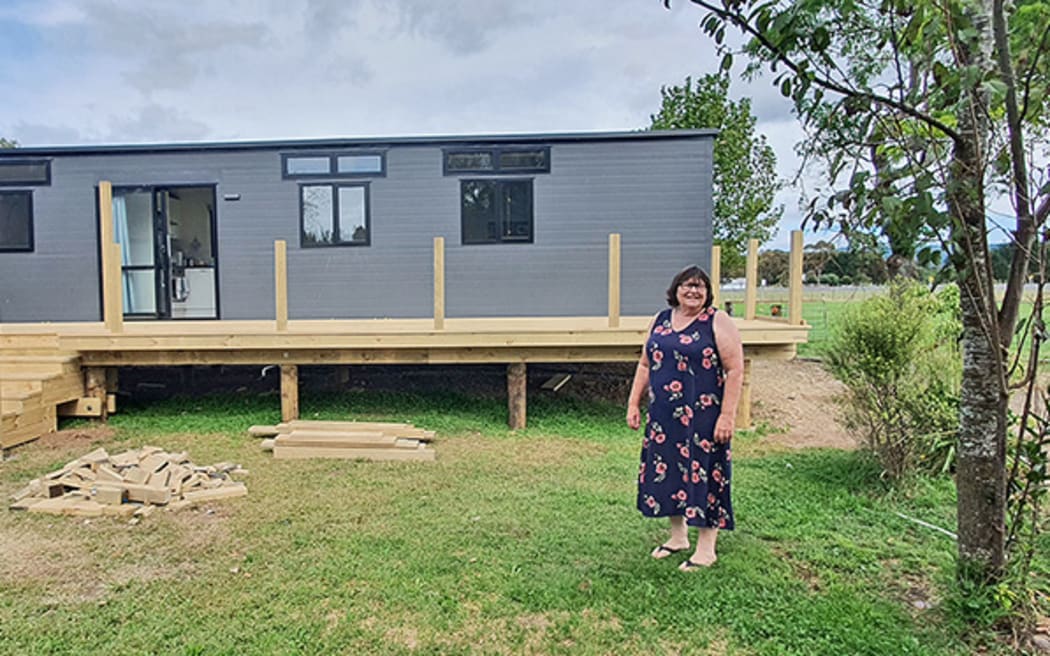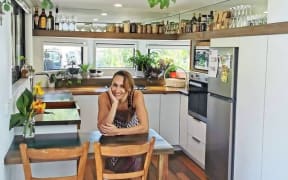
Jane Kay simply wanted to place her transportable tiny home in her daughter’s backyard, but has had to jump through hoops to make it compliant with Whakatāne District Council rules. Photo: LDR / Supplied
After struggling for 16 months and paying over $40,000 to jump through regulatory hoops, Jane Kay has finally achieved her goal of living in a tiny home on her daughter's Otakiri lifestyle property in the Bay of Plenty.
Kay said it was only with the help of advocacy group Whakatāne Housing Action Reform Enthusiasts (Whare) that she finally got there.
At a public meeting last week, nine months after the group's formation, the public heard that the Whakatāne District Council hopes to change the definitions of buildings in its District Plan to ensure no one else is ensnared by the same compliance nightmare.
Kay's trials began in November 2022, when, retiring at age 69, she bought a $102,500 transportable tiny home from an Auckland company.
The 37-square-metre home came with bathroom and kitchen fittings, fixtures and a building certificate of compliance from Auckland Council.

She had it placed in her daughter and son-in-law's backyard, within a few metres of their back door. She planned to connect it to the home's existing septic tank.
"Somebody told me that because my tiny home was on skids and was moveable, we didn't need building or resource consents (from the local council). We made, with advice, a huge rock base to make it stable and I had my house."
What Kay didn't realise at the time was that rules around secondary dwellings on properties differed greatly from one district to another, so the advice she had been given was wrong.
A district council compliance officer drove past and, noticing the tiny home, informed her that she would need to have it consented.
"In order to get building consent, I had to engage, first of all, geotech engineers, who took over three months, with great big machinery coming out through the paddocks drilling down to Asia."
She also had to engage an engineer to design new foundations, raising the home on piles.
Kay now needs to climb steps to reach it. She had to have a separate septic tank put in, which needed to be built with a higher specifications to the original home's tank and a higher drainage field, making it appear like a "giant's grave" in the paddock in front of the house.
During all of this work she was having to use the kitchen and bathroom in her daughter's home.
"I've had a couple of falls climbing in and out," she said.
"I got the building consent and I thought, whew, that's over. Now we can get going. But, although we were led to believe (by a council staff member) we didn't need the resource consent, it turned out we did. So then that challenge started."
At this stage, Kay engaged a consultant, as it was all becoming too difficult. The application was submitted in September 2023
After some confusion by the council around the address, the next query was about her landscape plan.
Then, after the resource consent was overdue, her consultant contacted council and was told that they had decided that they require feedback from Waka Kotahi (NZTA) regarding the vehicle crossing onto State Highway 34. The council said they were busy with this.
"All this for one little Honda Fit. The very next day we got another email saying, 'no, it's actually okay. We don't have to do that if your daughter, who owns the property, signs something to say the house will never be rented out'."
The following day a third message came to say that she needed to upgrade the entrance to conform to NZTA standards, sealed back to the property boundary, with an approved size of culvert.
This also necessitated submitting a corridor access request and a traffic management plan to NZTA.
Eventually, months later, after advocacy and advice from WHARE, contacting a district councillor and gaining a meeting with development and environment general manager David Bewley, she said this step was found to be unnecessary.
She is now happily living in her tiny home, with only some work to be done to finish off the deck. Then a final building inspection will be needed.
In the meantime, Kay has had to return to the workforce to pay for, so far, $40,794 of unexpected expenses, including consent application fees, engineers, surveyor and consultant fees, effluent treatment design and consent, a new septic tank, piles, and the removal and replacement of the house.
Fortunately, Kay has a glass-half-full attitude to life.
"I love my work, so it's not a problem. I've got to the end and have learnt a lot of lessons," she said.
She's happy that rules are changing so others won't have to go through a similar process in the future.
LDR is local body journalism co-funded by RNZ and NZ On Air.




